Technologies
Apple Watch Series 9 Review: New Tricks Make for a Minor Upgrade
With Double Tap and a faster Siri, the Apple Watch Series 9 is slightly easier to use. But it otherwise has a lot in common with the Series 8.

When it comes to the new Apple Watch Series 9, which starts at $399 (£399, AU$649) and is available now alongside the Apple Watch Ultra 2, it’s what’s on the inside that counts. That’s my biggest takeaway after spending a few days with the Series 9, which has an upgraded chip that powers faster Siri performance and new gesture controls called Double Tap.
It’s these additions that separate the Series 9 from last year’s Series 8, and they make the Apple Watch more convenient to use. But they’re not monumental enough to convince recent buyers to upgrade.
My time with the Series 9 so far suggests that new features like Double Tap may not show their usefulness right away. However, they could become helpful in the long run.
Double Tap takes some getting used to, and it’s not compelling enough on its own to justify buying the Series 9. But I’d be lying if I said I didn’t find myself using it to dismiss a notification and easily navigate back to my watch face here and there. (The version of Double Tap I tested was a preview, which I accessed on a separate review unit running an early software build of the feature.)
Siri’s most appealing update, the ability to answer health-related questions now that it can process data locally instead of in the cloud, isn’t coming until later this year. Yet if it works as promised, it could make the Series 9 a much more useful health tracker.
The Series 9 doesn’t have everything on my wish list. For example, I was hoping for longer battery life and the Apple Watch Ultra’s Action button. But as is the case with the iPhone 15, it will be a solid upgrade for those with an older model. That’s especially true for frequent Siri users and those who primarily use their Apple Watch for exercise and wellness tracking.
Apple Watch Series 9’s new Double Tap gesture

Apple rarely adds new gestures to the Apple Watch, so I was eager to try Double Tap. Just as the name implies, you trigger this feature by tapping your index finger and thumb together twice. Doing so allows you to dismiss a notification, pause your timer or access widgets from the watch face, among other actions. It’s programmed to perform whatever the primary action in a notification is, whether that be casting aside your standard reminder or replying to a text message.
The Apple Watch already supported a similar gesture through its AssistiveTouch accessibility mode. But Double Tap is baked into the Series 9’s user interface across the board, and its chip enables the watch to support this feature all day without impacting battery life. The pinching feature that’s included as part of the watch’s accessibility options, meanwhile, is meant to be customized based on a person’s needs.
Double Tap has a bit of a learning curve, but that could be because I’m using an early version of it. I most frequently use Double Tap to dismiss notifications, stop timers and send text messages hands-free. This was particularly useful while brushing my teeth before bed, since I like to check the time and my exercise progress before hitting the sack. When a notification was blocking my watch face, I pinched my fingers together to dismiss it without having to put down my toothbrush.
It’s a simple use case, but one that highlights the promise behind Double Tap. Being able to dictate a response to a text message without touching the watch could also be useful in situations when my hands are full, such as when I’m cleaning, cooking or even gripping the subway pole during my commute to work.
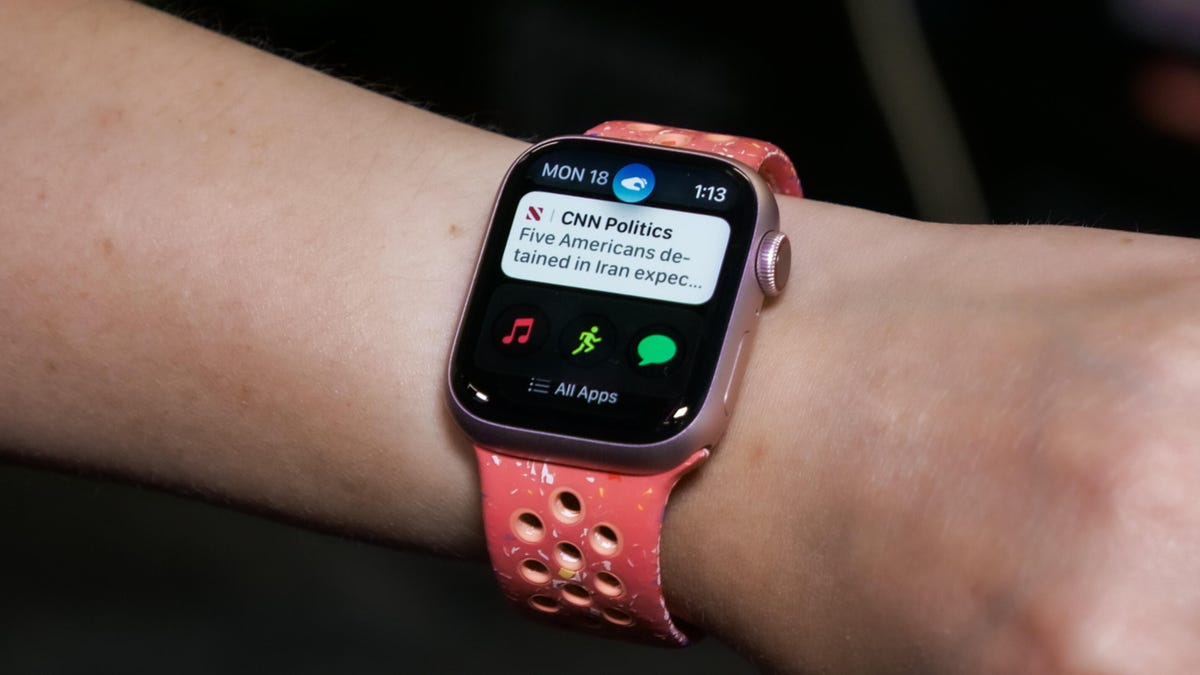
My biggest issue with Double Tap, however, is that it just doesn’t feel intuitive yet. We’ve been conditioned to tap, swipe and speak to our devices over the last two decades. Even though Double Tap came in handy during that one instance while I was brushing my teeth, my instinct usually tells me to tap my watch’s screen. It’s going to take time to break that habit.
Double tapping can also look awkward to those who aren’t familiar with it. When I tested the Apple Watch Series 9 over the weekend, a friend began giving me strange looks when I started pinching the air with my fingers.
Double Tap doesn’t feel as game-changing as other user experience-related updates the Apple Watch has received over the years, like the Series 5’s always-on display. But who knows — maybe it’ll start to feel natural. After all, everyone thought AirPods looked goofy at first, but now they’re everywhere. Double Tap doesn’t feel like a reason to upgrade, but we’ll know more when the feature fully launches.
Siri gets a speed boost on the Series 9
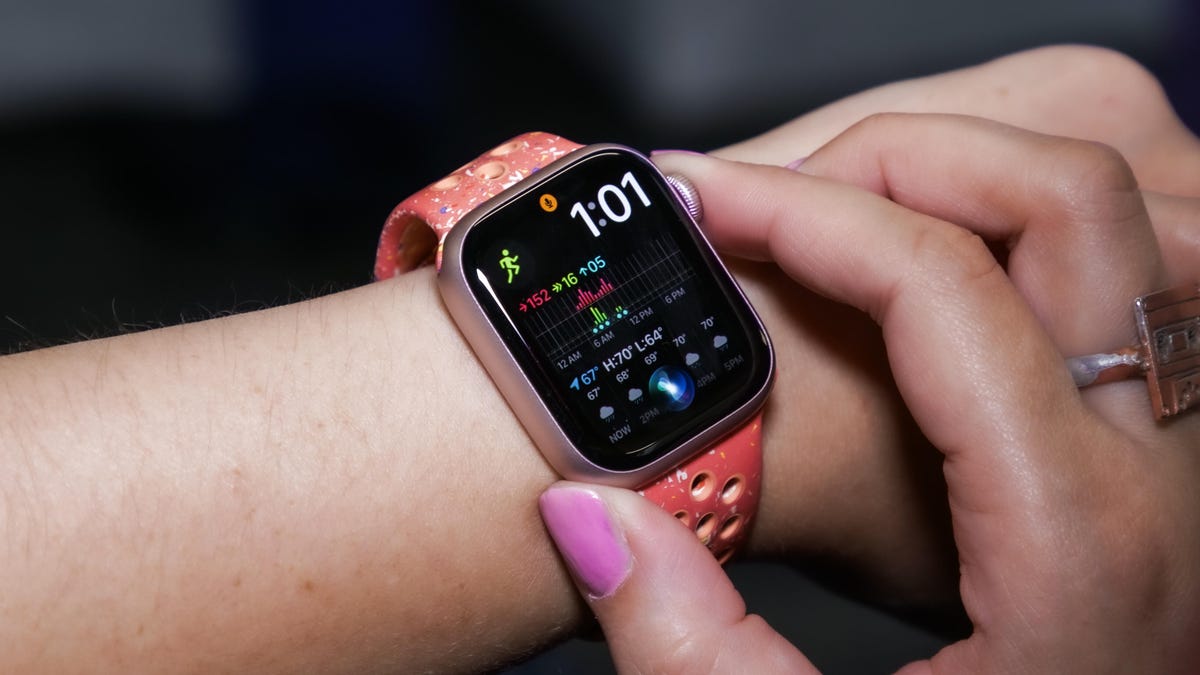
Another benefit from the Series 9’s new S9 processor is a faster Siri experience. Siri can now answer requests slightly faster for two reasons. First, certain queries that Siri doesn’t need to rely on the internet to answer, like setting alarms or timers, now happen on the watch. Dictation is also supposed to be up to 25 percent more accurate, which should mean Siri understands you correctly the first time.
Coming from the Series 8, I noticed a difference. I use Siri daily for setting alarms and timers, especially when I’m stretching before a workout. I often repeat myself when using my Series 8 or the Series 6 I bought roughly three years ago. That hasn’t happened as much on the Series 9 so far.
I also timed how long it took for Siri to respond to certain questions on the Series 9 compared to the Series 8. For this test, I only asked questions that Siri could answer without plucking an answer from the web. Siri was faster on the Series 9 in almost every scenario, as you can see in the table below.
Series 9 vs. Series 8: Siri response times
| Series 9 (in seconds) | Series 8 (in seconds) | |
|---|---|---|
| «Set a timer for 5 minutes» | 1.73 | 2.52 |
| «Cancel my timer» | 1.66 | 1.74 |
| «Set an alarm for 9 a.m.» | 1.81 | 1.93 |
| «Start an outdoor walk» | 3.39 | 3.32 |
| «Stop my workout» | 2.33 | 3.06 |
| «Cancel my alarm» | 1.94 | 2.2 |
Siri will soon be able to answer health-related queries, which should make it easier to quickly parse all the activity and health metrics your watch gathers throughout the day and night. But it won’t be launching until later this year.
I’ve been waiting for a feature like this because finding what I’m looking for in Apple’s Health app isn’t always intuitive. Manually logging activity data and finding specific metrics, like exercise minutes for the past week, can take a couple of taps. Using Siri should hopefully make queries like these much faster and more convenient.
It’s also nice to see Siri playing a larger role on the Apple Watch. Smartwatches aren’t ideal for long touchscreen interactions given their small size, so they present an opportunity for voice assistants like Siri to shine.
Apple Watch Series 9 is better at finding your iPhone
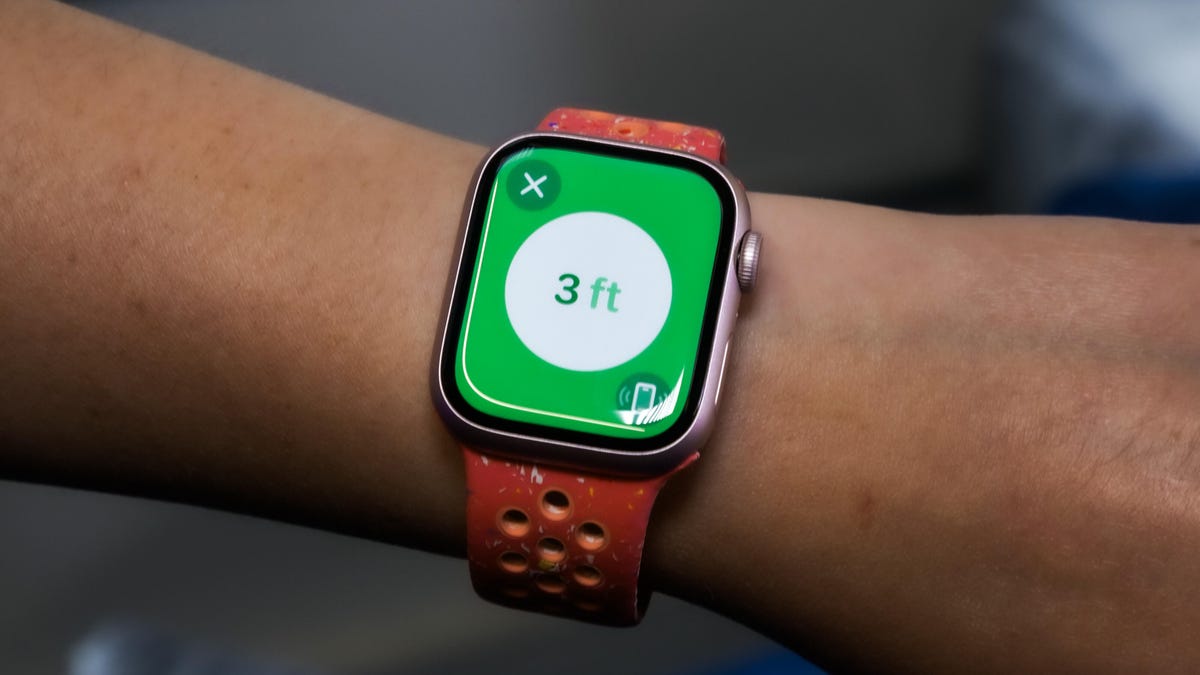
If you’re anything like me, the Apple Watch has been a godsend for tracking down your misplaced iPhone when it slips between the couch cushions. Apple made the watch an even more useful iPhone locator, thanks to the second-generation ultra-wideband chip inside. Not only can you ping your iPhone, but the Series 9 will show an estimate of how far away you are from your phone, along with a nudge in the right direction.
The catch, however, is that this feature only works if you have an iPhone 15 or iPhone 15 Pro, since those are the only Apple phones to also have the new ultra-wideband chip. That means unless you plan to buy a new iPhone along with your Apple Watch, you won’t be able to use it.
To put the Apple Watch’s new Precision Finding feature to the test, I had a friend of mine hide my iPhone 15 in my apartment while I waited in another room. He chose a difficult hiding spot; tucked underneath my living room carpet, a place where my phone is never likely to end up, even by accident. But the Apple Watch pointed me to the exact corner where my phone was hidden almost immediately, and I was able to track it down in less than five minutes.
To be fair, the audible chime that my iPhone emitted when being pinged by my Apple Watch also played a big role in helping me find it. That feature is already available on existing Apple Watches and iPhones. But being able to see how many feet away I was from my phone added an extra layer of confidence that I was looking in the right direction. This could be helpful if I lost my phone in a noisy environment like a restaurant.
The new chip also brings tighter HomePod integration, allowing you to see media suggestions at the top of your watch’s widget stack when you’re within 4 meters of the device. While these new features are limited to those who own the iPhone 15 or a HomePod, I’m glad to see Apple finding new ways to put ultra-wideband to use. It’s something I’ve been hoping to see in future Apple Watches, as I wrote back in 2022.
Same health and wellness as the Series 8
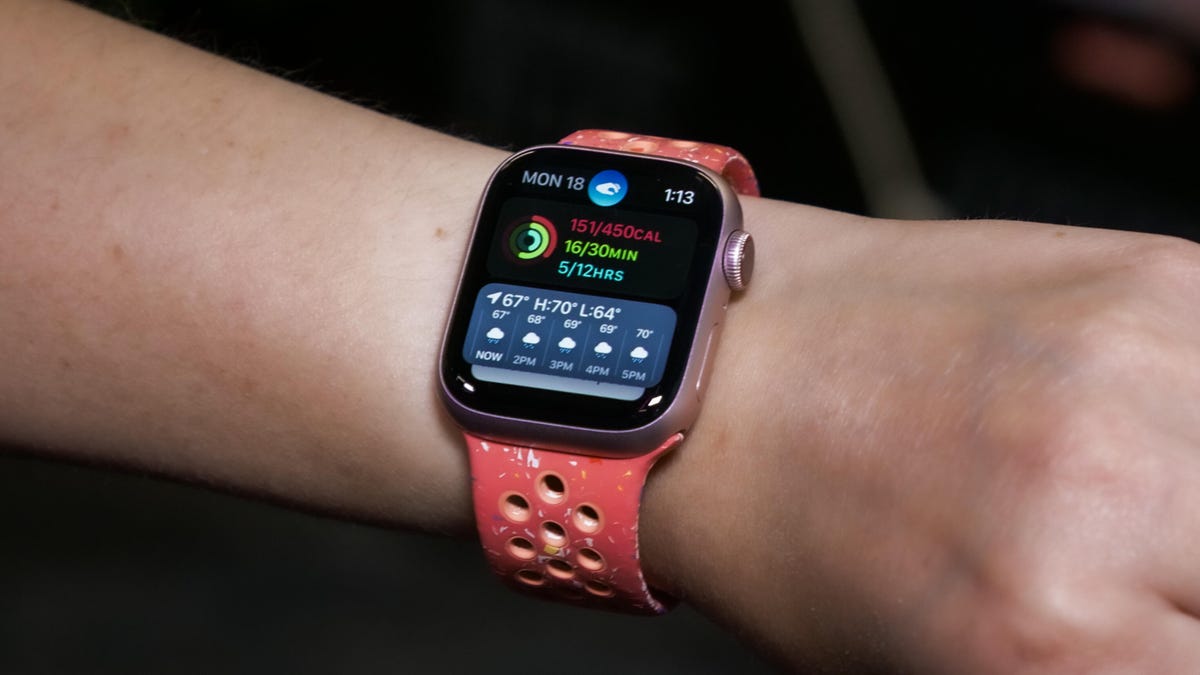
The Series 9 inherits the same health and safety features as the Series 8. That includes the ability to take an ECG, temperature sensing, blood-oxygen detection, high and low heart-rate notifications, irregular heart rhythm notifications, sleep stage tracking, fall detection and crash detection. It’s also rated for the same degree of dust and water resistance as last year’s Series 8.
The Apple Watch’s broad selection of health metrics is exactly what you might expect of a smartwatch at this price, and it’s likely more data than most people need. But I’m still waiting for more features aimed at rest and recovery, a key area where other wellness and sports devices from brands like Oura, Fitbit, Garmin and Whoop excel over Apple. These gadgets can analyze bodily markers and activity trends to assess how well rested you are, which can be easier to decide whether it’s time for a workout or a rest day. However, Apple doesn’t charge a subscription fee to access all health insights, unlike Fitbit, Oura and Whoop, which require memberships to get the full experience.
No Action button and the same battery life as Series 8
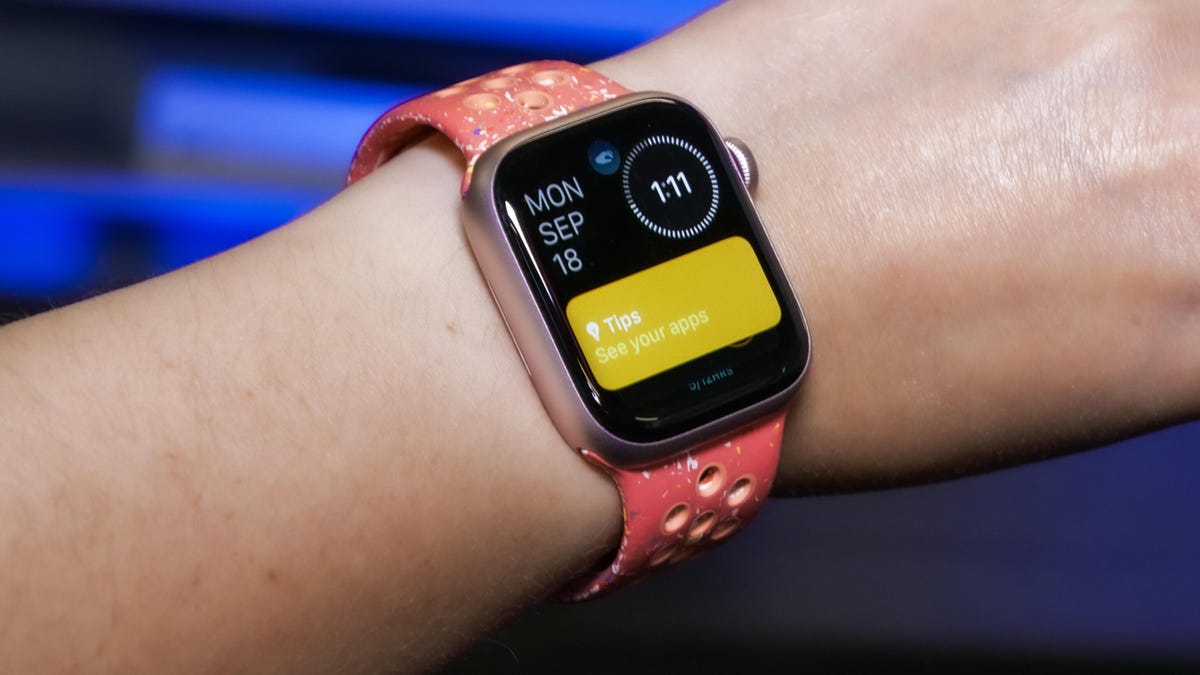
The Series 9’s theme is seemingly focused on convenience rather than new health features. That’s why I was hoping the Series 9 would gain the Apple Watch Ultra’s Action button, a programmable key that lets you perform tasks like starting a workout or a stopwatch with just a tap.
While keeping certain features exclusive to the Ultra line is understandable given its higher price, the Action button feels like it should be part of the broader Apple Watch experience. The Ultra already has plenty of other features to distinguish it from the Series 9 and SE, including a bigger and brighter screen, longer battery life, a more durable design and a depth gauge, among other extras. The Action button would have fit nicely with the Series 9’s other upgrades aimed at helping you navigate the watch more easily.
The Series 9 has an always-on display, just like every flagship watch model since the Series 5, which is a key feature that separates it from the less expensive $249 Apple Watch SE. While the overall design is the same, Apple reduced its carbon footprint to make the Series 9 paired with a Sport Loop band the company’s first carbon neutral product.
It’s also rated for the same 18-hour battery life as the Series 8, which means it should last for one to 1.5 days on a single charge, depending on how you’re using it. On one hand, that’s impressive considering the Series 9 has a brighter screen and a more powerful processor.
But I wouldn’t mind sacrificing some of these new features, like a brighter screen or faster Siri, if it meant having longer battery life. I often find myself choosing between wearing my Apple Watch to sleep or leaving it on the charger overnight so that it’s ready to log my morning walk and afternoon workout. Having a battery that lasts for more than a day and a half means I wouldn’t have to make that decision.
Since I’ve been switching between my main Series 9 review unit and a separate unit with an early version of Double Tap, I haven’t been able to get a solid sense of the Apple Watch’s battery life. But I’ll update this review accordingly with more details.
Apple Watch Series 9: Final thoughts

The Series 9 feels like a minor upgrade over the Series 8. New features like Precision Finding and faster Siri performance make the Series 9 a better smartphone companion. But it’s not worth it unless you’re a first-time buyer or have the Series 6 or earlier.
Coming from an older watch like the Series 6, you’ll have plenty to gain. In addition to what’s new on this year’s model, you benefit from a larger screen with a keyboard, a temperature sensor and noticeably faster performance compared to a 3-year-old watch. If you have an Apple Watch SE and are craving more health metrics, the Series 9 is also a worthwhile upgrade.
Like many recent Apple Watch updates, such as the Series 8’s temperature sensor, there’s potential for the Series 9’s new features to evolve and become more helpful over time. It signals a promising direction for the Apple Watch, aligning with the tick-tock pattern Apple has seemingly followed over the last several years. Apple typically alternates between bringing new health sensors to the watch and launching updates related to convenience and the general user experience. This year happens to be the latter.
But right now, the Series 9 feels like a refreshed version of the Series 8 rather than an entirely new generation.
Technologies
Judge Blocks Texas App Store Age-Check Law
A preliminary injunction found the Texas law, set to begin Jan. 1, is «more likely than not unconstitutional.»
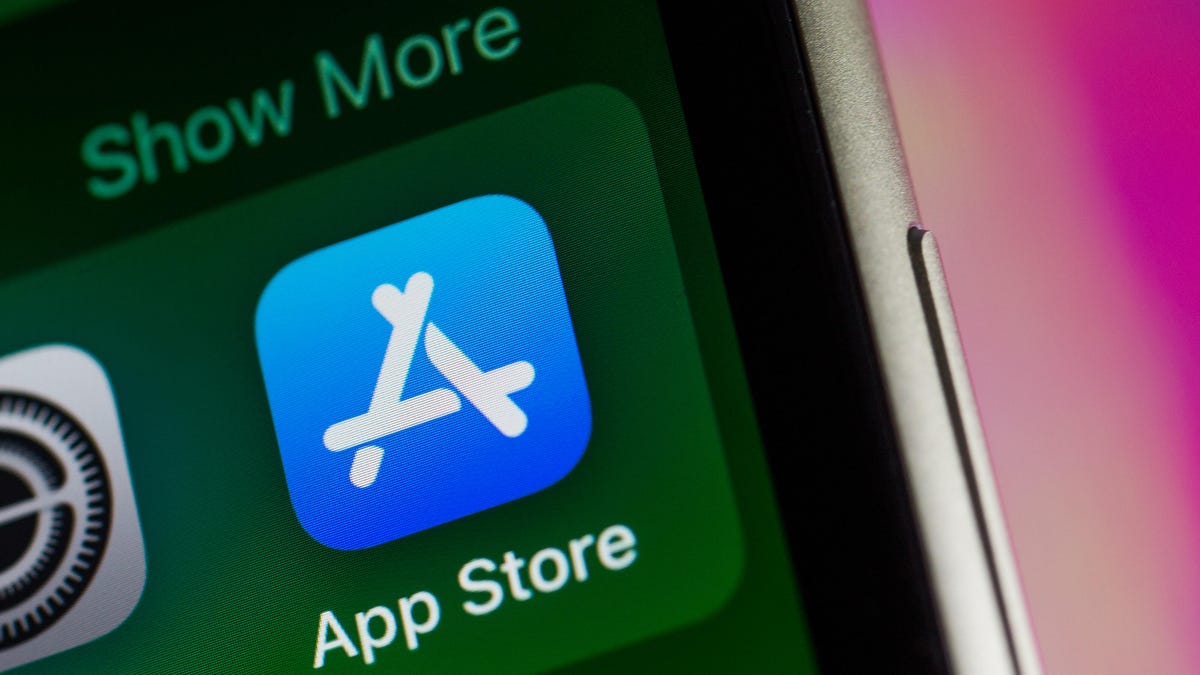
A new Texas state law set to take effect on Jan. 1 would have required app stores to implement age verification processes. But the law has been put on hold, at least temporarily, by a federal court judge.
As reported by the Texas Tribune, Senate Bill 2420, also known as the Texas App Store Accountability Act, is the subject of a temporary injunction issued by US District Judge Robert Pitman.
Pitman said in his decision that the law as written is broad, vague and «more likely than not unconstitutional.» However, he also wrote the court «recognizes the importance of ongoing efforts to better safeguard children when they are on their devices.»
Don’t miss any of our unbiased tech content and lab-based reviews. Add CNET as a preferred Google source.
The Texas law, signed into law by Governor Greg Abbott in May, requires app store operators — including Apple, Google, Nintendo, Steam and more — to build age verification processes for the storefronts and to only allow downloads to minors who obtain parental consent. The injunction is a ruling in an October lawsuit filed by the Computer & Communication Industry Association.
CCIA senior vice president Stephanie Joyce said in a statement, «This Order stops the Texas App Store Accountability Act from taking effect in order to preserve the First Amendment rights of app stores, app developers, parents, and younger internet users. It also protects parents’ inviolate right to use their own judgment in safeguarding their children online using the myriad tools our members provide.»
Other individuals and the advocacy group Students Engaged in Advancing Texas also filed suits over the law, the Texas Tribune reported.
App Store Accountability Act
The bill author, State Senator Angela Paxton, said the bill was meant to give parents «common sense tools to protect their kids and to survive court challenges by those who may have lesser priorities.»
The language of Texas Senate Bill 2420 does not only include mobile app stores from Apple or Google, but any «website, software application, or other electronic service that distributes software applications from the owner or developer of a software application to the user of a mobile device.»
By that definition, websites with links to browser games or mobile game consoles with download options would fall under the Texas law as written. The law also defines mobile devices as including phones and tablets, as well as any other handheld device capable of transmitting or storing information wirelessly.
The parental consent aspect of the law requires those under 18 to have an app store account affiliated with a parent or guardian to purchase or download applications.
Age verification elsewhere
In an effort to keep adult materials out of reach of minors and to protect children from potentially harmful content and interactions, tech companies have been compelled by law or through legal action to verify the age of users.
Roblox, which has a huge audience of minors, began rolling out stricter age verification after investigations and lawsuits hurt its reputation as a safe gaming space. Australia is perhaps the most large-scale example of a government restricting access to online content. In December, Australia began restricting social media access to those 16 and older. Reddit recently challenged that law.
In the US, age verification laws have primarily targeted adult sites. Texas already has a law on the books that requires adult sites to age-block their content. The Supreme Court upheld that law in a June ruling. The UK has also enacted age restriction rules for adult sites as have other US states.
Technologies
Today’s NYT Mini Crossword Answers for Thursday, Dec. 25
Here are the answers for The New York Times Mini Crossword for Dec. 25.

Looking for the most recent Mini Crossword answer? Click here for today’s Mini Crossword hints, as well as our daily answers and hints for The New York Times Wordle, Strands, Connections and Connections: Sports Edition puzzles.
Need some help with today’s Mini Crossword? Of course, there’s a very Christmassy clue involved. And once you solve the entire puzzle, look at the letters used in all the answers and see what they have in common. (5-Across will tell you!) Read on for all the answers. And if you could use some hints and guidance for daily solving, check out our Mini Crossword tips.
If you’re looking for today’s Wordle, Connections, Connections: Sports Edition and Strands answers, you can visit CNET’s NYT puzzle hints page.
Read more: Tips and Tricks for Solving The New York Times Mini Crossword
Let’s get to those Mini Crossword clues and answers.
Mini across clues and answers
1A clue: ___ King Cole, singer with the album «The Magic of Christmas»
Answer: NAT
4A clue: Body drawings, informally
Answer: TATS
5A clue: Letters to ___ (what this Mini was made with)
Answer: SANTA
6A clue: Huge fan, in slang
Answer: STAN
7A clue: «Illmatic» rapper
Answer: NAS
Mini down clues and answers
1D clue: Grandmothers, by another name
Answer: NANAS
2D clue: Abbr. before a name on a memo
Answer: ATTN
3D clue: Org. with long lines around the holidays
Answer: TSA
4D clue: «See ya later!»
Answer: TATA
5D clue: Govt.-issued ID
Answer: SSN
Don’t miss any of our unbiased tech content and lab-based reviews. Add CNET as a preferred Google source.
Technologies
Don’t Let a Border Agent Ruin Your Holiday Trip. Travel With a Burner Phone
Yes, you should leave your main phone at home and take a cheap burner this winter.

Prepare for a whole new level of border-crossing anxiety this holiday season: the high-probability of a phone search. New figures from US Customs and Border Protection say agents aren’t just glancing at your lock screen anymore — they are aggressively ramping up device inspections, even for citizens coming home. We aren’t just talking about a quick scroll through your photos, either. Agents are increasingly using forensic tools to clone and analyze everything on your device.
The stats are genuinely alarming. In just a three-month window this year, nearly 15,000 devices were flagged for searches, with over a thousand subjected to deep-dive data copying. If you’re traveling with your primary phone, you are essentially carrying your entire digital existence into a legal gray zone where privacy is optional.
The smartest defensive play is remarkably low-tech: the burner phone. By traveling with a secondary, stripped-down device, you ensure your private data stays safe at home while you stay connected abroad. But privacy isn’t the only perk. Moving to a «dumb» phone is the ultimate digital detox, helping you escape the notification trap that usually ruins a vacation.
Even figures like Conan O’Brien have ditched the smartphone to cut through the noise. Whether you’re dodging invasive border searches or just trying to enjoy your trip without being glued to a screen, a burner might be the best travel investment you make this year.
Read more: Best Prepaid Phone of 2025
Although carriers have offered prepaid phones since the ’90s, «burner phones» or «burners» became popular in the 2000s following the celebrated HBO series The Wire, where they helped characters avoid getting caught by the police. Although often portrayed in that light, burners aren’t only used by criminals; they’re also used anyone concerned with surveillance or privacy infringement.
What is a burner phone, and how does it work? Here’s everything you need to know about burners and how to get one.
Don’t miss any of our unbiased tech content and lab-based reviews. Add CNET as a preferred Google source.
What is a burner phone?
A burner phone is a cheap prepaid phone with no commitments. It comes with a set number of prepaid call minutes, text messages or data, and it’s designed to be disposed of after use.
Burner phones are typically used when you need a phone quickly, without intentions of long-term use. They’re contract-free, and you can grab them off the counter. They’re called burner phones because you can «burn» them (trash them) after use, and the phone can’t be traced back to you, which makes them appealing to criminals. Of course, those committed to illicit activities often do more than just throw these phones in the trash, and often completely obliterate the SIM cards and other materials by smashing them with a hammer or melting them away.
Burners are different from getting a regular, contract-bound cellphone plan that requires your information to be on file.
Why should you use a burner phone?
Burner phones are an easy way to avoid cellphone contracts or spam that you get on your primary phone number. Burners aren’t linked to your identity, so you can avoid being tracked down or contacted.
You don’t have to dispose of a burner phone after use. You can add more minutes and continue using it. Burner phones can still function as regular phones, minus the hassle of a contract.
You can also get a burner phone as a secondary phone for a specific purpose, like having a spare phone number for two-factor authentication texts, for business or to avoid roaming charges while traveling. Burner phones are often used by anyone concerned with privacy.
Read more: The Data Privacy Tips Digital Security Experts Wish You Knew
Burner phones, prepaid phones, smartphones and burner SIMs: What’s the difference?
Burner phones are cheap phones with simple designs that lack the bells and whistles of a smartphone. Because they’re designed to be disposable, you only get the essentials, as seen by the most common version, the flip phone.
All burner phones are prepaid phones, but not all prepaid phones are burners. What sets a burner apart is that you won’t have to give away any personal information to get one, and it won’t be traceable back to you. Again, a burner phone is cheap enough to be destroyed after use.
Prepaid smartphones are generally low-end models. You can use any unlocked smartphone with prepaid SIM cards, essentially making it a prepaid phone.
If you want a burner, you don’t necessarily have to buy a new phone. You can get a burner SIM and use it with an existing phone. Burner SIMs are prepaid SIMs you can get without a contract or giving away personal information.
Where can you buy a burner phone?
Burner phones are available at all major retail outlets, including Best Buy, Target and Walmart. They’re also often available at convenience stores like 7-Eleven, local supermarkets, gas stations and retail phone outlets like Cricket and Metro.
You can get a burner phone with cash, and it should cost between $10 and $50, although it may cost more if you get more minutes and data. If you’re getting a burner phone specifically to avoid having the phone traced back to you, it makes sense to pay with cash instead of a credit card.
If you just want a prepaid secondary phone, you can use a credit card. Just keep in mind that credit cards leave a trail that leads back to you.
There are also many apps that let you get secondary phone numbers, including Google Fi and the Burner app. However, these aren’t burners necessarily because the providers typically have at least some of your personal information. Additionally, apps like Google Talk require a phone number that’s already in use for you to choose a number with the service.
If you’re just looking to get a solid prepaid phone without anonymity, check out our full guide for the best prepaid phone plans available. We also have a guide for the best cheap phone plans.
-

 Technologies3 года ago
Technologies3 года agoTech Companies Need to Be Held Accountable for Security, Experts Say
-

 Technologies3 года ago
Technologies3 года agoBest Handheld Game Console in 2023
-

 Technologies3 года ago
Technologies3 года agoTighten Up Your VR Game With the Best Head Straps for Quest 2
-

 Technologies4 года ago
Technologies4 года agoBlack Friday 2021: The best deals on TVs, headphones, kitchenware, and more
-

 Technologies4 года ago
Technologies4 года agoVerum, Wickr and Threema: next generation secured messengers
-

 Technologies4 года ago
Technologies4 года agoGoogle to require vaccinations as Silicon Valley rethinks return-to-office policies
-

 Technologies4 года ago
Technologies4 года agoOlivia Harlan Dekker for Verum Messenger
-

 Technologies4 года ago
Technologies4 года agoiPhone 13 event: How to watch Apple’s big announcement tomorrow
